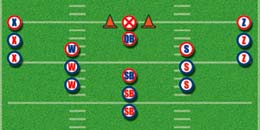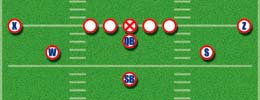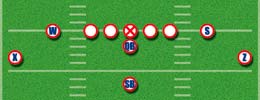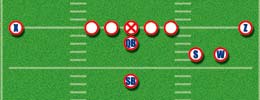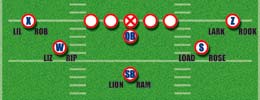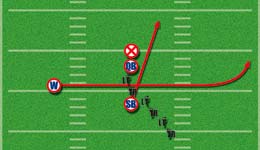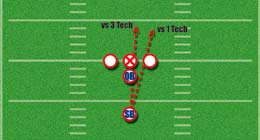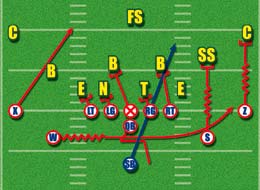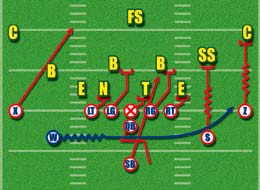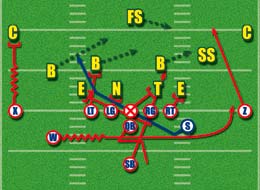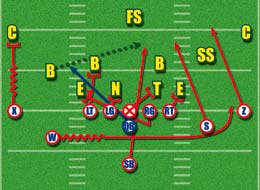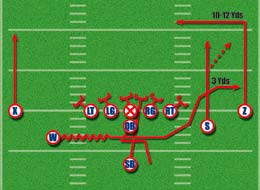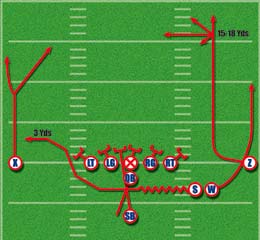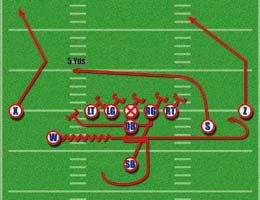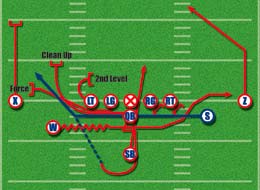Article CategoriesAFM Magazine
|
Inside The Hornet\'s NestPut some sting in your offensive arsenal with the hornet seriesby: Wayne Anderson Wide Receivers Coach, Waynesburg College © More from this issue As coaches we are always looking for a new idea or concept that agrees with our own personal offensive or defensive philosophy. When it comes to seeking out new information, I am no exception. An article that captured my attention was featured under AFM’s old name, American Football Quarterly, entitled, “High-flying Hornets” (Volume 4, 1st Quarter). The article focused on current Texas State University-San Marcos (formerly Southwest Texas University) head coach, Manny Matsakis, and the “Sting-and-Shoot” offense that he employed while he was coaching at Emporia State University. At that time, the Sting-and-Shoot offense was putting up great offensive numbers lead by running back Brian Shay. By the end of his college career in 1998, Brian Shay became the all-time leading rusher in NCAA history up to that point at all levels. This accomplishment destroyed the myth that you need a fullback and tight end to have an effective running attack. With my background in the Run-and-Shoot offense, I was looking for something to add to my own offensive system. After studying the article, I was fortunate to have the opportunity to listen to Coach Matsakis lecture on the Sting-and-Shoot offense at the AFQ University in Ft. Worth, Texas, in 1998. Coach Matsakis was also gracious enough to speak with me one-on-one about some of the concepts of his offensive system. With the information gathered, I used some of Coach Matsakis’ basic concepts and developed the “Hornet” Series. The Hornet Series The Hornet Series is a system of plays run out of multiple one-back formations that can be used as a base offense or can be integrated as part of one’s existing offensive system. This article will explore some of the basic concepts of the series as well as four running plays and four pass plays that are part of the overall package. Installation The key to the Hornet Series is that all the plays are based on the dive and sweep plays (Diagrams 8 & 9). This being the case, it is most important to get the timing down that is required to run these two plays effectively. In order to achieve this, you can take a 10-minute block of time during your pre-practice and work on the fundamental aspects of the quarterback’s footwork and ball handling, the tempo of the man in motion and the proper track of the superback. These three skills are the most important aspects required for the successful execution of any play in the Hornet Series. You do not need to use a football in your drill in order to achieve success because this drill is about timing and not ball control. My suggestion is to use a towel for the center to simulate the snap and a water bottle in the hands of your quarterback. In your drill, line up your skill players in an even formation. Use two cones for landmarks to represent the inside leg of the guards (Diagram 1).
Motion The footwork of the quarterback is basically the same on all of the plays in the Hornet Series. For instance, if “H” Dive Right is called, at the snap of the ball, the quarterback will take his first step with his left foot at six o’clock. As the quarterback is taking his second step with his right foot at six o’clock, he is riding the ball to the motion man coming across the formation. As the quarterback plants his second step, he will hand the ball off to the superback and run out his playaction pass drop. If “H” Sweep Right was called, the footwork would be the same, but the quarterback would hand the ball off to the motion man coming across, ride the superback and then run out his play action pass drop (Diagram 6).
The key coaching point is for the quarterback to have a good knee
bend. This helps greatly in the deception of the play. If the quarterback
is more erect,
it makes him slower in his footwork and that can cause problems with the timing
of the play. The track of the superback depends on the technique of the defensive tackle
to the playside. If there is a three technique to the playside, then the track
of
the superback is the outside leg of the center. If there is a one technique,
then the track of the superback is the inside leg of the guard (Diagram 7). The predominant running plays out of the Hornet Series are the “H” Dive
and the “H” Sweep (Diagrams 8 & 9). As I stated earlier,
these two plays are the basis of the entire series. All other plays in the
series are
based on these two plays. When success is achieved with these two plays,
defenses will begin to shift over to try to out flank you. For this reason
a backside
running attack is needed to counter-act a shifting defense and make them
play honest. Two such backside running plays are “H” Counter
Trap and “H” Spinner
Trap (Diagrams10 & 11).
“H” Pass (Diagram 12) Assignments:
“H” Bowe Pass (Diagram 13)
“H” Boot Pass (Diagram 14)
“H” Screen (Diagram 15)
Copyright 2024, AmericanFootballMonthly.com All Rights Reserved |


